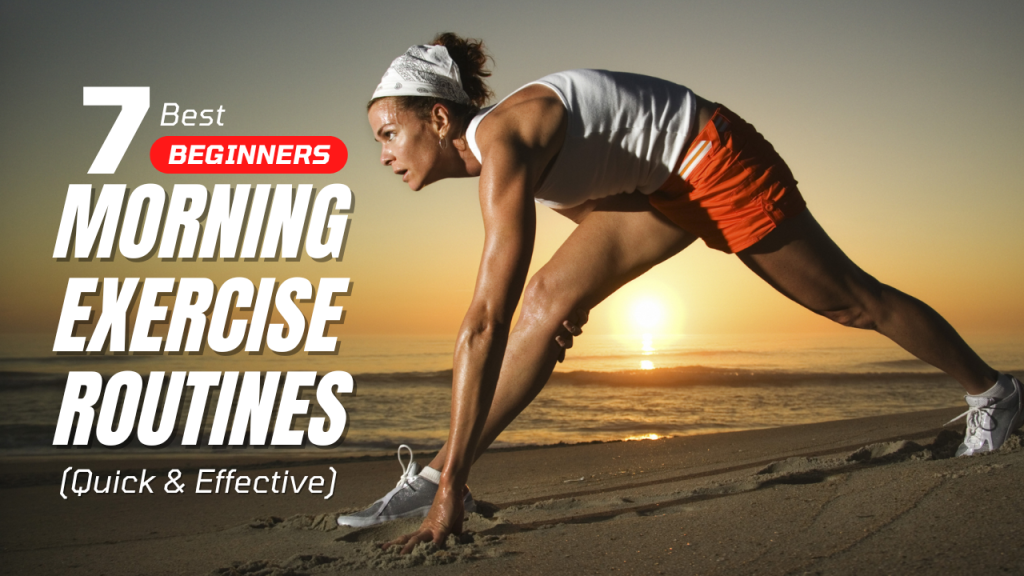Starting your day with a morning exercise routines can boost your energy, improve your mood, and enhance your overall health. If you’re a beginner, it’s essential to follow a simple yet effective plan that you can sustain. Here’s a structured guide with exercises that are easy to do at home, including time frames, durations, and rest periods.

Table of Contents
Perks of This Exercise Routine
Incorporating this morning exercise plan into your daily routine offers numerous benefits:
- Boosts Energy Levels: Helps wake up your body and mind for the day ahead.
- Enhances Mood: Releases endorphins, reducing stress and promoting happiness.
- Improves Flexibility: Regular stretching prevents stiffness and enhances movement.
- Strengthens Muscles: Increases core, leg, and upper body strength gradually.
- Aids in Weight Management: Burns calories and improves metabolism over time.
- Enhances Circulation: Improves blood flow, delivering oxygen and nutrients efficiently.
- Builds a Healthy Habit: Establishing a morning routine sets a positive tone for the day.
Morning Exercise Plan for Beginners
Total Duration: 20-30 minutes
Equipment: None (optional: yoga mat)
Intensity: Low to moderate
Goal: Improve flexibility, strength, and stamina
1. Warm-Up (5 Minutes)
Objective: Prepare your body for exercise and prevent injuries.
- Neck Rolls – 30 seconds (15 seconds per side)
- Shoulder Rolls – 30 seconds
- Arm Circles – 30 seconds (both directions)
- Torso Twists – 30 seconds
- Leg Swings – 30 seconds per leg
- March in Place – 1 minute
Rest: 30 seconds before moving to the main exercises
2. Bodyweight Squats (2 Minutes)
Benefits: Strengthens legs and glutes, improves balance.
- Perform 10-12 reps per set (2 sets)
- Lower yourself down as if sitting on a chair
- Keep your chest up and knees aligned
Rest: 30 seconds
3. Standing Leg Raises (2 Minutes)
Benefits: Strengthens the core and lower body.
- Lift one leg forward, hold for 2 seconds, and lower it
- Repeat with the other leg (10 reps per leg, 2 sets)
Rest: 30 seconds
4. Knee Push-Ups (2-3 Minutes)
Benefits: It builds upper body strength without straining joints.
- Lower your chest toward the floor, then push back up
- Perform 10 reps per set (2-3 sets)
Rest: 30 seconds
5. Seated Knee Tucks (2 Minutes)
Benefits: Strengthens core muscles and improves posture.
- Sit on a mat, bring your knees toward your chest, then extend them out
- Perform 12 reps per set (2 sets)
Rest: 30 seconds
6. Standing Side Bends (2 Minutes)
Benefits: It engages the obliques and enhances core flexibility.
- Lean to one side with one arm raised overhead
- Hold for a second, then return to the center
- Perform 10 reps per side (2 sets)
Rest: 30 seconds
7. Cool Down & Stretching (5 Minutes)
Objective: Relax muscles and improve flexibility.
- Deep Breathing – 30 seconds
- Forward Bend Stretch – 30 seconds
- Seated Hamstring Stretch – 30 seconds per leg
- Shoulder Stretch – 30 seconds per side
- Neck Stretch – 30 seconds per side
Conclusion
This beginner-friendly morning exercise routine is an excellent way to start your day. Stick to this plan consistently to build strength, flexibility, and endurance. As you progress, you can gradually increase repetitions and add variations. Stay hydrated, eat a balanced breakfast, and enjoy the benefits of an active lifestyle.
Frequently Asked Questions (FAQs)
How often should I do this morning exercise routine?
You can perform this routine 5-6 days a week, ensuring you have at least one rest day for muscle recovery.
Can I do these exercises if I have joint pain?
Yes, but modify movements to reduce impact. For example, do half squats instead of full squats, and avoid exercises that cause discomfort.
Do I need any equipment for these exercises?
No equipment is required, but using a yoga mat can add comfort during floor exercises.
How long before I see results?
With consistency, you may start noticing improvements in strength, flexibility, and energy levels within 2-4 weeks.
Can I do these exercises in the evening instead of the morning?
Yes! While morning workouts boost metabolism, you can do this routine at any time that fits your schedule.
Should I eat before exercising?
A light snack (such as a banana or a handful of nuts) is recommended if you feel low on energy, but avoid heavy meals right before working out.
What should I do if I feel sore after exercising?
Mild soreness is normal. Stay hydrated, stretch properly, and take a rest day if needed to allow recovery.





